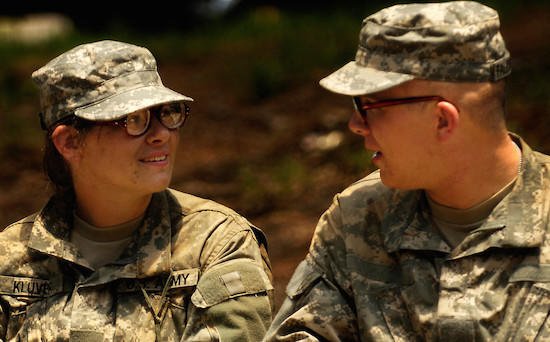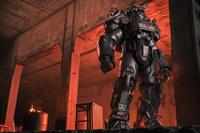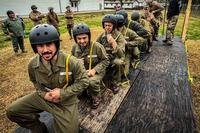
BY DAVID NYE — WEARETHEMIGHTY.COM
At the pointy end of the spear (and in the rear with the gear) there are official nomenclatures that you’ll find on procurement documents and supply forms and then there are the names that troops really use to identify something. Here are 37 terms that fleet players use to refer to the some of the stuff they use every day:
1. 100-mph tape
Basically, duct tape. Oddly enough, the tape called duck tape, duct tape, and 100-mph tape was supposedly named duck tape by American troops in WWII. When Duck Tape became a registered trademark, the military had to start using a different name for it in manuals and publications. 100-mph tape was substituted, but the actual tape is the same.
2. 30 mike-mike

(Photo: US Air Force Tech. Sgt. Fernando Serna)
The 30mm grenade launcher or the ammunition that it fires, most commonly used to refer to the cannon on an Apache helicopter or an A-10 attack plane. Another version of this is 40 mike-mike, referring to a 40mm grenade launcher, like the M320 or Mark-19, or the ammunition those weapons fire.
3. 5-ton
A large truck used to move supplies and troops. It is commonly misreported that the 5-ton (10,000 lb.) nickname comes from the weight of the truck, but it’s actually the cargo weight the vehicle is rated to carry in off-road conditions. Most of the trucks that have carried the nickname have actually weighed over 10 tons.
4. Alice/Molle/Ruck
The large backpack troops carry in the field. Alice and Molle are both named for the acronym that described a specific generation of the equipment. ALICE stood for all-purpose, lightweight individual carrying equipment. MOLLE stands for Modular Lightweight Load-carrying Equipment. Ruck is simply short for rucksack.
5. Ass

(Photo: Gunnery Sgt. Robert K. Blankenship)
A military asset with a lot of firepower, generally referring to armored vehicles or tanks.
6. Bird
An aircraft.
7. Birth control glasses (“BCGs”)

(Photo: Stacey Pearsall)
Glasses given out in basic training that were nearly impossible to look attractive in. Designated the S9, the frames were dropped in 2012 for the 5A, frames with a slimmer, more contemporary look.
8. Boomstick
A weapon, most commonly an M4 or M16. This nickname is generally used by someone trying to sound stupid for comedic effect.
9. Cammies

(Photo: US Navy Mass Communications Specialist 3rd Class Michael Starkey)
Camouflage uniform for blending into the environment.
10. CHU
Pronounced “chew,” CHU is an acronym for containerized housing unit. CHUs are shipping containers that are built to be shipped on trains and boats like normal cargo, but can be quickly converted into living areas on arrival at a base.
11. Deuce-and-a-half
A truck designed to carry at least 2.5 tons (5,000 lb.) of cargo. The first truck to carry the designation was the GMC CCKW. The current deuce-and-a-half, the M35, is being replaced by the family of medium tactical vehicles. The FMTV has different models, but only one will continue the legacy of the “deuce and a half,” all other variants will carry 5 tons or more.
12. Donkey Dick
A flexible spout that can be screwed onto a gasoline can, especially the 5-gallon jug most commonly carried by military vehicles.
13. E-tool

(Photo: US Navy Photographer’s Mate 1st Class Brien Aho)
A shovel. The official term for the foldable shovel troops carry is an “entrenching tool.”
14. Fart sack
For Marines and soldiers, this is most commonly used to refer to sleeping bags. The Air Force will also use this term to refer to flight suits.
15. Fast mover
A jet, especially one that is providing close air support.
16. Full battle rattle
All combat equipment assigned to a service member. When troops are told to get into full battle rattle, it typically includes body armor, helmet, knees and elbow pads, ballistic glasses, ear plugs, gloves, weapons, and load carrying equipment.
17. Green Ivan
Pop-up targets used at ranges to test marksmanship. Green Ivans are made of shaped green plastic in the rough shape of a soldier complete with helmet and rifle.
18. Hangar queen

(Photo: US Navy Mass Communication Specialist 3rd Class Anthony W. Johnson)
An aircraft in the maintenance area that is being used for parts.
19. Hooch
A shelter. While “hooch” is sometimes used to refer to a service member’s room in a building, it is most commonly used to mean a small tent, sometimes improvised from items like tarps or ponchos.
20. Hook-and-loop tape
Commonly called Velcro. Like 100-mph tape, this term is used because Velcro is trademarked. The fasteners work by pushing together two pieces of cloth or plastic tape, one covered in tiny plastic hooks and one covered in tiny loops of thread or plastic. The hooks sink into the loops and hold fast.
21. JDAM

(Photo: US Air Force Master Sgt. Andy Dunaway)
Most service members use JDAM to refer to a GPS-guided, large bomb dropped from a plane, but it is more accurately a kit attached to the bomb. JDAM stands for joint direct attack munition, and it is a kit that combines GPS and a inertial guidance systems. The kit is attached to bombs between 500 and 2,000 lb. that do not have built-in guidance systems. The JDAM kit can guide the bomb to within a few meters of designated GPS coordinates.
22. Ka-bar

(Photo: Wikimedia Commons/Nicolas von Kospoth)
A utility and combat knife used by service members since WWII, most famously the Marine Corps. “Ka-bar” is used to refer to any knife of the correct style, but it’s most properly used to refer to the original knife made by KA-BAR, a knife company based out Olean, New York.
23. Kevlar/Steel pot
A helmet. Both nicknames are in current circulation, but U.S. helmets have not been made of steel since the early 1980s. Kevlar fibers were originally used in the PASGT helmet and are still a major component of the current helmet, the advanced combat helmet (ACH).
24. Mah-deuce/Fitty
Nicknames for the M2, .50-cal. machine gun. “Mah-deuce” refers to the M2 nomenclature while “fitty” is a deliberate mispronunciation of the weapons caliber.
25. Moonbeam
A flashlight. This nickname is most commonly used in the Marine Corps.
26. MOPP

(Photo: US Marine Corps Sgt. Kevin R. Reed)
Gear used to protect troops from chemical, biological, and nuclear attacks. MOPP is an acronym for mission oriented protective posture.
27. NODs/NVGs
Night vision devices. NOD is an acronym for night optic devices. NVG is an initialism that stands for night vision goggles. The nicknames are used interchangeably by troops.
28. Pajamas
A derogatory name for flight suits due to the suits’ visual similarity to onesie pajamas. The suits are a single-piece coverall that zips up the front.
29. Pig

(Photo: US Navy Photographer’s Mate 1st Class Arlo K. Abrahamson)
Originally referred to the M60 machine gun, a 7.62mm machine gun that served in every branch of the armed forces. It was most famously used by ground troops in Vietnam. The M60 has been replaced by the M240, but the “Pig” is a legend even among troops who have never seen one.
30. SAPI plate
The armored plates that go into modern body armor. SAPI is an acronym that stands for “small arms protective insert.” The plates can stop 7.62mm or smaller rounds but are surprisingly susceptible to damage from drops of even a few feet.
31. Snivel gear
Cold weather gear worn by service members in uniform. Snivel gear is famously issued in a variety of styles with many being banned from wear. “Poly pros” and “waffle tops” are long underwear that, along with gloves, troops are generally allowed to wear. Other items, like most outer jackets, face coverings, or hats, are issued, but troops are seldom allowed to wear them.
32. Canopy/streamer/cigarette roll

(Photo: US Army Spc. Paolo Bovo)
A parachute. “Canopy” refers to an open parachute. “Streamers” and “cigarette rolls” are parachutes that have malfunctioned, deploying from the pack but not inflating with air. Senior paratroopers will sometimes refer to a newer jumper’s chute as a streamer or cigarette roll in order to make the jumper nervous by implying that the chute will malfunction.
33. Swab
A mop. This term is most commonly used by the U.S. Navy.
34. Tillie

(U.S. Navy photo by Photographer’s Mate Airman Gregory A. Pierot)
The crash crane on a U.S. Navy carrier to move damaged planes on the flight deck.
35. Tootsie roll
An artillery or mortar round. These rounds are transported in black cardboard tubes that resemble massive tootsie rolls.
36. Water buffalo
A large container for water. Though it is sometimes used to refer to bladders used for water storage on forward bases, the term is most commonly used for water tanks on trailers pulled behind military trucks.
37. Willy Pete

(Photo: US Air Force)
White phosphorous, which can be used for two purposes. First, as a smoke screen to protect friendly troops from observation. Since the smoke is extremely flammable, WP’s second use is to destroy enemy equipment or kill massed troops. Multiple white phosphorous round are dropped in the target area and, once the smoke has spread, a high explosive round is dropped to detonate the white phosphorous. This tactic is referred to as “shake-and-bake” or “Willy Pete plus H.E.” It’s use is limited by international agreements.

David Nye - Staff Writer at We Are The Mighty
David is a former Fort Bragg paratrooper who deployed with the 82nd Airborne Division's 4th Brigade Combat Team.
MORE POSTS FROM WE ARE THE MIGHTY:
The 7 Cheesiest Military Movies Of All Time
The most important guy in military aviation history you’ve never heard of
11 Things You Probably Didn’t Know About ‘Saving Private Ryan’
We Are The Mighty (WATM) is dedicated to serving the military community with authentic entertainment and original content. With a team of military veterans and civilian military supporters, WATM features premium original and curated video programming of all genres as well as photography, stories, quizzes, lists and much more. For more, visit the We Are the Mighty site.




